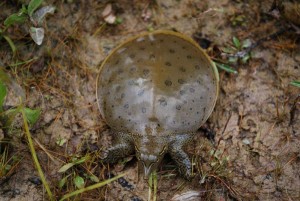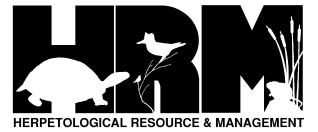Eastern Spiny Softshell Turtle
Overview:
Scientific Name: Apalone spinifera spinifera
Size: 5 – 18.9” (adult carapace length)
Status: Locally common in the western part of its Great Lakes range but uncommon to rare and local in the east. Have declined in some areas due to pollution, exploitation, and elimination of nesting sites. Nearly extirpated from western Lake Ontario, were reportedly common just a few decades ago.

Habitat:
Rivers and larger streams, inland lakes, reservoirs, and even protected bays and river mouth areas in Great Lakes. Tolerate relatively swift current but prefer sand or mud bottom and usually avoid streams with sharp-edged rocks or coarse gravel. Open habitats with little aquatic vegetation favored over those with dense vegetation. Basking spots and sandy nesting areas are important components of suitable habitat.
Adult Coloration:
Tan, brown, or olive carapace with black spots, flecks, and circles in males, while females are darker and become blotched or mottled with gray or brown. Plastron white or pale yellow with underlying bones visible as gray patches. Head, neck, and legs tan or olive above and speckled or mottled with black. Feet often streaked or mottled with yellow and black. Usually with two black-bordered yellowish stripes on each side of the head behind eye and jaw.
Adult Characteristics:
Smooth, flat, oval or round carapace and long piglike snout. Both carapace and plastron lack scutes and are soft and rubbery with flexible edges. Short, often inconspicuous spines present at front of carapace. All four feet fully webbed. Females are much larger than males (9.4 – 18.9” vs. 5 – 9.4” carapace length). Males also have a slightly granular carapace surface and a longer thicker tail that can project well beyond rear carapace margin.
Juvenile Characteristics:
1.2 – 1.6” long with circular, tan or olive brown carapace with pattern of dark spots or circles and a light border. New hatchlings have a curled shell and turned up nose, which unfold within a day or two after emergence
Species Confused With:
No other Great Lakes turtle has a flat, scuteless carapace and tubular nose. Softshell Turtle eggs are spherical like Snapping Turtle eggs, but are smaller and have a less rigid shell.
References:
- Amphibians and Reptiles of the Great Lakes Region by Jim Harding
- Harding, J.H. and J.A. Holman. 1990. Michigan Turtles and Lizards. MSU Cooperative Extension Service and MSU Museum. 96 pp.
- Ruthven, A. G., H. B. T. Gaige, et al. 1912. The herpetology of Michigan, by Alexander B. Ruthven. Crystal Thompson and Helen Thompson; Memoranda towards a bibliography of the archaeology of Michigan, by Harlan I. Smith; prepared under the direction of Alexander G. Ruthven. Lansing, Mich., Wynkoop Hallenbeck Crawford, State Printers.
- Holman, J. A. 2012. The Amphibians and Reptiles of Michigan: A Quaternary and Recent Faunal Adventure. Detroit, Mich., Wayne State University Press.
- Conant, R., and Collins, J. T. 1998. Reptiles and Amphibians: Eastern, Central North America. Houghton Mifflin Harcourt Press.
